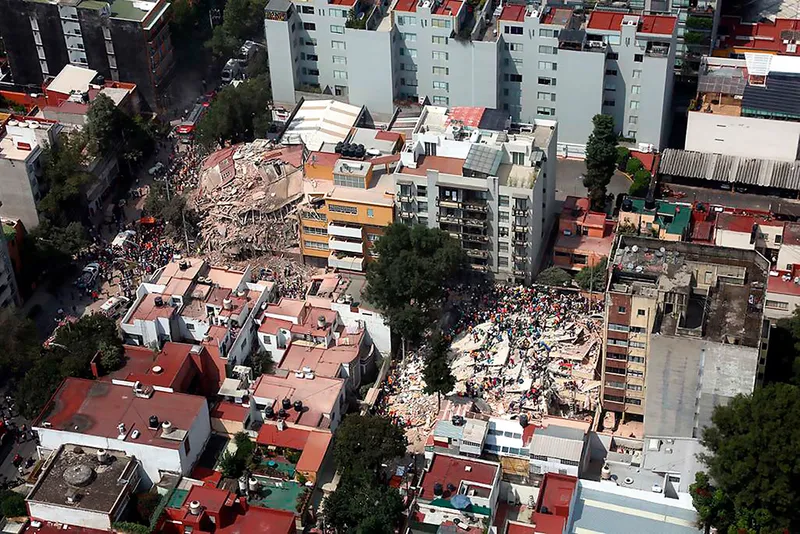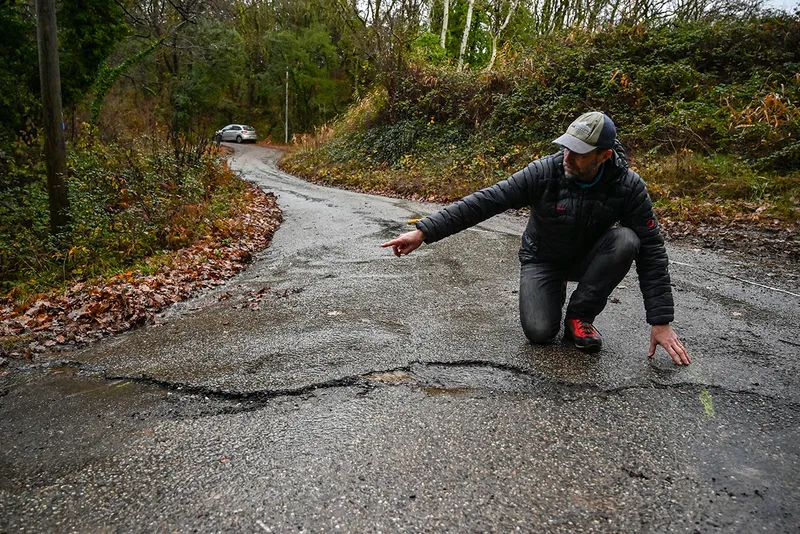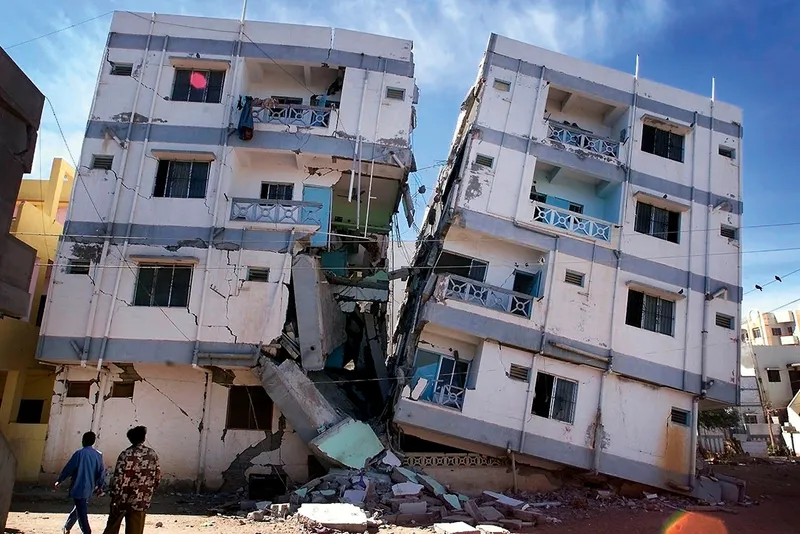When it comes to earthquakes, always expect the unexpected. That’s the message coming from seismologists Prof Éric Calais, of the École Normale Supérieure (ENS) in Paris, and Jean François Ritz, Director of Montpellier’s CNRS Laboratoire Géosciences.
Underpinning their advice is the reality that Earth sometimes shakes in places it shouldn’t. These mysterious events, called intraplate earthquakes, happen far from the active margins of tectonic plates and in places that are otherwise geologically quiet.
Gaining a better understanding of them and an explanation for them has become the mission of the French scientists.
Unpredictable and destructive
The rocky plates that make up the brittle, outer carapace of our world are performing a slow dance across the face of the planet, moving at about the same rate that a person’s fingernails grow.
While nearly all the geological action worth talking about takes place where the tectonic plates meet, intraplate quakes are different, occurring in the interiors of the plates far from the margins.
There are good, potentially lifesaving, reasons for Calais and Ritz to want to shed more light on them. Intraplate quakes are rare: the number of significant shakes is tiny compared to what happens at the edges of the plates, with Calais noting that only 20 of a magnitude of 6 and above have been recorded since 1974.
That’s less than half of one per cent of the number of similarly sized quakes at plate margins over the same time. Their rarity, and typically long return periods, makes them difficult to predict, yet they’re capable of causing immense destruction in unprepared urban centres that never regarded quakes as a problem.
undefined
Intraplate earthquakes can happen anywhere that a geological fault is present in the crust. In the last few centuries, they’ve been recorded as far apart as Basel in Switzerland, New York and Boston in the US, and the St Lawrence River in Canada.
More recently, they’ve caused substantial damage in the Australian city of Newcastle and, in 2017, in the southern African country of Botswana and Puebla, Mexico, the latter resulting in close to 400 deaths.
The magnitude of the problem
Calais and Ritz draw attention to a magnitude 5 earthquake that happened close to the Rhône Valley village of Le Teil in 2019, while in 2008 a magnitude 5.2 event beneath the Lincolnshire town of Market Rasen rocked much of England.

What a local newspaper referred to as “The Great Rasen Earthquake” injured one person and caused damage estimated at around £20 million. While the tremors that strike the UK and France tend to be small, this is far from the case in other parts of the world.
In 2001, the most devastating intraplate quake of modern times – a magnitude 7.6 event that struck Bhuj in the Indian state of Gujarat – destroyed an estimated 300,000 buildings and claimed up to 20,000 lives.
Going further back in time, a quake of magnitude 7 (or thereabouts) hit the US east-coast city of Charleston in 1886, killing 60 people and inflicting widespread damage. A little over 80 years earlier and around 1,200km (approx 765 miles) to the west, three powerful intraplate quakes struck in the New Madrid region of Missouri from December 1811 to February 1812.
Registering magnitudes of up to 7.5, these resulted in violent tremors across an area almost three times the size of those that hit the UK and 10 times larger than those associated with the great San Francisco earthquake of 1906.
As the region at the time was sparsely populated, the overall impact was not as devastating as it could have been, but local destruction was severe. In Europe, cities far from a plate boundary are at risk from large, if rare, quakes, including Brussels in Belgium, and Geneva and Basel in Switzerland.
The latter is of particular interest: on 18 October 1356, a series of violent intraplate quakes – the largest being a magnitude of 6.6 – and the fire that followed, destroyed huge areas of the city.
Despite being one of the largest recorded quakes in central Europe, the human toll was smaller than could be expected as the population of Basel was only about 6,000, and many had already fled when the main event happened due to a powerful foreshock earlier in the day.
Adding to the strain
One thing that both intraplate earthquakes and those at the plate margins have in common is their operating mechanism. Essentially, strain accumulates over time on a geological fault – a weakness in the Earth’s crust – until it reaches a critical level that causes the fault to break or rupture.
This is what causes a quake: the rupture releasing energy in the form of seismic waves so as to reduce the strain to zero. Then, the whole process starts over. Strain can accumulate along the great geological faults that mark the contacts between individual plates, such as San Andreas in California.
At the plate boundaries, this strain is monitored using GPS, strain meters and other methodologies, and – based on the average return period of past quakes on a fault – rough estimates can be made about when the next is likely to happen. Calais observes that the frequency in California is typically a couple of hundred years.
In relation to faults that host intraplate quakes, however, there’s a problem. Such structures are often old and deeply buried, and on occasion their existence isn’t suspected at all until after they’ve hosted an earthquake.
The absence of any record of past events makes it impossible to estimate when the next one might happen. Indeed, as Calais points out, some intraplate quakes might even be so-called ‘orphan’ events that aren’t part of a series and which involve the one-off reactivation of an ancient fault that hasn’t ruptured for millions of years.
While the mechanism of strain accumulation and release is the same for both intraplate quakes and those that happen at plate boundaries, the triggers that cause rupture may well be different.
Fault rupture at the edges is provoked by plate movement, but Calais and Ritz propose something different for the plate interiors: discrete triggers that occur rapidly, at least on a geological timescale.
These can include unloading due to the melting of ice sheets or surface erosion; rainfall seeping down from the surface; or fluids working their way up from the Earth’s mantle.

Mining and the filling of new reservoirs have been linked to intraplate seismicity, as well as, extraordinarily, the atmospheric pressure fall that arises from the passage of a tropical cyclone.
Intricacies of the intraplate
At this point, it’s worth noting that a fault that’s primed and ready to rupture can be induced to do so by pressure equivalent to that of a handshake. So, while it may have taken millions of years for strain to accumulate on an ancient intraplate fault, setting it off can happen over a relatively short period of time.
Calais and Ritz have zeroed-in on the aforementioned 2019 Le Teil quake and come to the conclusion that it was probably triggered by an unloading of the crust above following the melting of glaciers in the region at the end of the ice age, perhaps aided and abetted by nearby quarrying.
In fact, unloading and deformation of the crust due to the rapid melting of the great ice sheets between about 20,000 and 10,000 years ago has been implicated in the promotion of many intraplate quakes, including New Madrid, Charleston and Basel.

At the end of the ice age, Norway and Sweden experienced an earthquake ‘storm’ as a result of the rapid melting of the 3km-thick (1.9-mile) Scandinavian Ice Sheet, which unloaded intraplate faults beneath and allowed them to release the strain that had been accumulating over tens of thousands of years.
The result was a number of colossal magnitude 8 quakes, one of which – around 8,200 years ago – triggered a giant submarine landslide off the coast of Norway that launched a tsunami into the North Atlantic. The waves reached heights of 20m (65ft) across Shetland and 6m (20ft) on the east coast of Scotland.
Prediction woes
So what does this all mean for the future? Calais highlights the difficulty of predicting intraplate quakes. “With these special earthquakes, it’s very complicated to calculate future risks, especially as they can sometimes only occur once in a given location,” he says. “We lack objective indicators to assess future intraplate seismicity”.
Nonetheless, studies have been undertaken that focus on the threat posed by intraplate quakes in areas that have been affected by them in the past. The results make for unnerving reading.
Today, more than half the world’s population is urbanised, and cities in areas affected by intraplate quakes have grown considerably in size. Basel, for example, is now the second largest urban centre in Switzerland, hosting a population of around half a million people, and the city is a major centre for banking and the chemical industry.
The consequences of a quake similar to that of 1356 would be far more serious. According to the Swiss Seismological Service, this would result in 3,000 deaths and up to 80,000 buildings suffering moderate to very severe damage.
In the US, Charleston is now an urban centre of more than three quarters of a million people, mostly living in masonry or concrete buildings, rather than wooden as at the time of the 1886 earthquake.

That means any comparable event would be both far more destructive and deadly. Even worse, a 2009 study funded by the US Federal Emergency Management Agency (FEMA) predicted that, were there to be a magnitude 7.7 quake in the vicinity of the early 19th century events in New Madrid, the impact would be felt across eight states, with Missouri and Tennessee the hardest hit.
The major urban centres of Memphis and St Louis would be the most severely affected, leading – the study estimated – to more than 700,000 damaged buildings, 3,500 deaths and the displacement of more than 7 million people.
New York is far from safe from a future quake, too. Although a magnitude of 7 is possible, having an estimated return period of 3,400 years means that an intraplate quake is extremely rare.
Consequently, there’s no requirement for buildings to be able to stand up to the shaking arising from a quake of that size. The corollary is that, if one happened, hundreds of thousands of buildings would be destroyed or damaged, and thousands of people killed.
But much smaller events could also significantly impact a city that’s poorly prepared. Even a magnitude 5 quake, comparable to one that struck New York in 1884 and expected every hundred years or so, could be lethal and result in a repair bill adding up to billions of dollars.
When it comes to future intraplate earthquakes, there’s one other major factor to consider: global heating. As glaciers and ice sheets melt, the reduced load on the crust beneath is leading to faults releasing long-accumulated strain.
This has been observed in parts of Alaska, where a vertical kilometre of ice (0.6 miles) has been lost in some areas. The big worry, however, is Greenland. In 2019, the ice sheet shed more than half a trillion tonnes of ice, which is enough, when melted, to flood the whole of the UK to a depth of 2.5m (8ft).
The crust beneath is uplifting as a consequence and an eventual hike in intraplate quake activity has been predicted. While Greenland is sparsely populated, the potential for such quakes to trigger submarine landslides capable of generating tsunamis means that everyone living around the margins of the North Atlantic should take note. Could it be that we’re facing a shakier future, as well as a much hotter one?
Read more:
